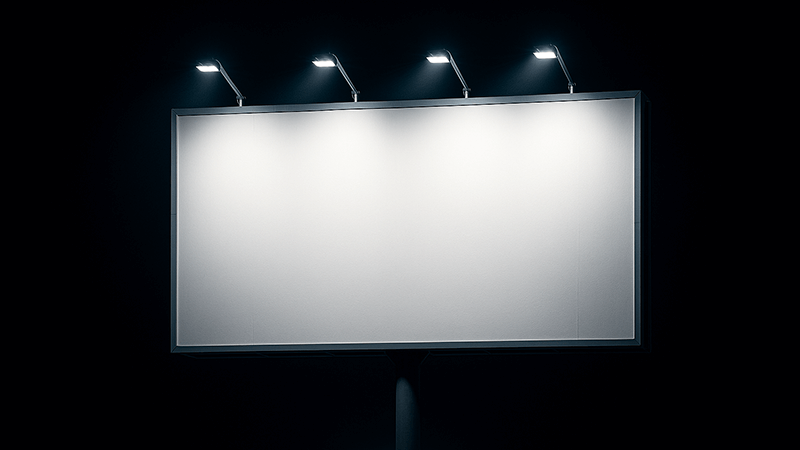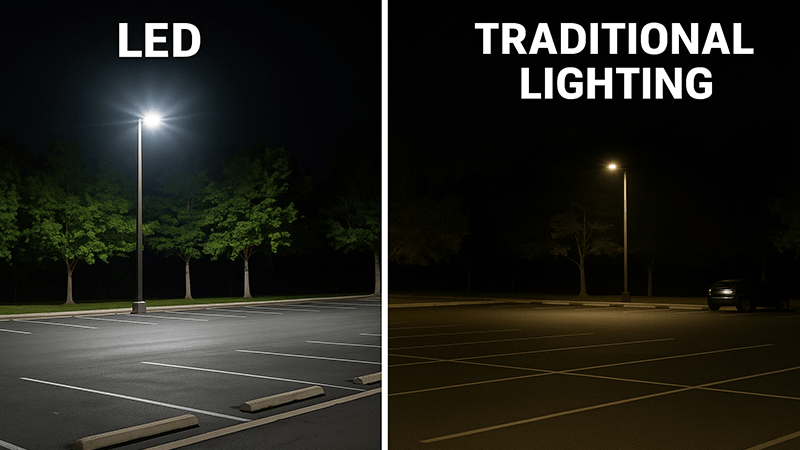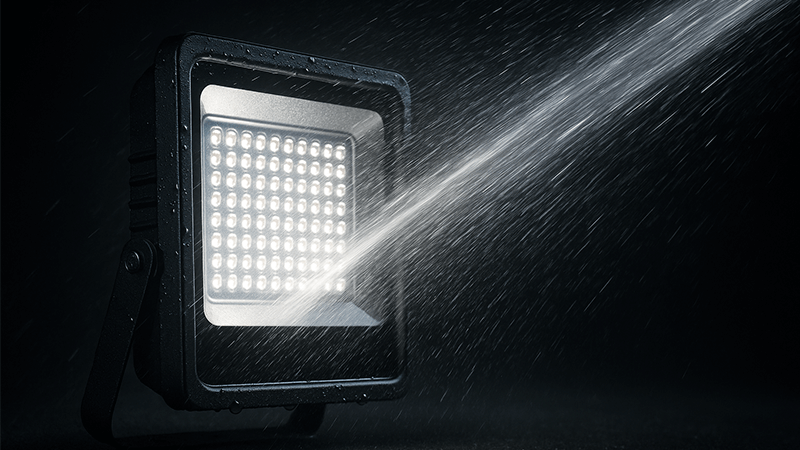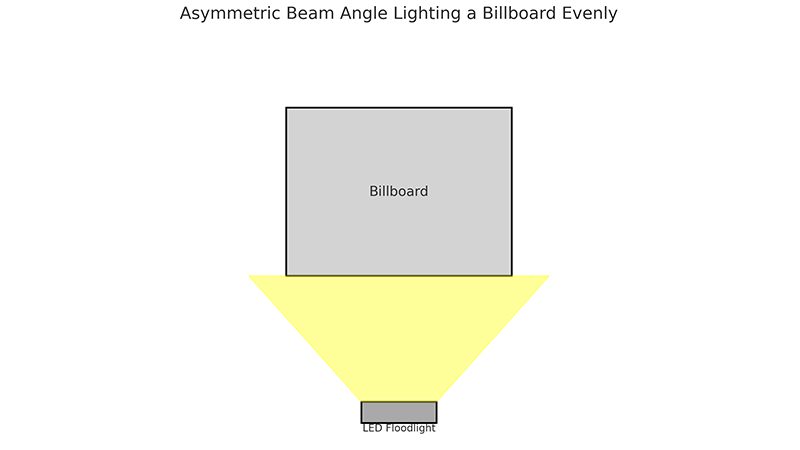Are your ads lost in the dark? Poor lighting makes billboards invisible, wasting your budget. LED floodlights make your message shine bright, grabbing attention and driving results.
LED floodlights are perfect for outdoor advertising because they offer powerful, efficient brightness to grab attention. They are also durable, long-lasting, and highly customizable, ensuring your message is seen clearly in any weather, making them a smart, cost-effective investment for impactful campaigns.

Now that you know the basics, you probably have more questions about how to choose the right lights. It’s a big investment, and getting it right is important. Let’s break down the details so you can make the best choice for your projects and clients. I’ve spent my career in this industry, and I want to share what I’ve learned to help you succeed.
Is LED better for outdoor lighting?
Tired of high energy bills and frequent bulb changes from old lights? Traditional lighting is costly and unreliable for outdoor use. LEDs save you money and reduce maintenance headaches.
Yes, LED is significantly better for outdoor lighting. It consumes up to 80% less energy than traditional options, has a much longer lifespan, and offers superior durability. This means lower operational costs and greater reliability for any outdoor application, from security to advertising.

When I first started in a lighting factory years ago, we mostly worked with Metal Halide (MH) and High-Pressure Sodium (HPS) lamps. They were the standard, but they had big problems. They used a lot of power, got incredibly hot, and needed replacing all the time. When LED technology became viable for high-power applications, it changed everything. For my clients, the switch to LED wasn’t just an upgrade; it was a total change in how they managed their outdoor spaces. The benefits are just too big to ignore.
Energy Efficiency and Cost Savings
The biggest and most immediate advantage of LED is energy savings. LEDs are incredibly efficient. They convert most of the electricity they use into light, not heat. Traditional bulbs are the opposite; they waste a huge amount of energy as heat. For a business owner or a project manager like Shaz, this translates directly to lower electricity bills. A project I worked on for a client with a chain of retail stores saw their lighting energy costs drop by over 70% just by retrofitting their old MH floodlights with LEDs. The savings paid for the entire upgrade in less than two years.
Longevity and Reduced Maintenance
Outdoor advertising needs to be on 24/7, or at least all night. Changing bulbs on a high billboard is expensive and dangerous. You need to hire a lift, a crew, and shut down lanes of traffic. LED lights last so much longer than traditional options.
| Light Type |
Average Lifespan (Hours) |
Key Disadvantage |
| LED |
50,000 – 100,000+ |
Higher initial cost |
| Metal Halide (MH) |
6,000 – 15,000 |
Long warm-up time, poor color shift over time |
| High-Pressure Sodium (HPS) |
16,000 – 24,000 |
Very poor color rendering (orange light) |
As you can see, LEDs last 3 to 5 times longer. This means fewer replacements, less downtime for your advertisement, and significant savings on maintenance labor and equipment costs over the life of the light.
Durability and Safety
Outdoor lights face tough conditions like rain, wind, and temperature changes. Unlike old bulbs with fragile filaments and glass tubes, LEDs are solid-state lights. They don’t have sensitive parts that can break easily from vibration or impact. They also run much cooler, reducing the risk of fire. This makes them a safer and more robust choice for any public or commercial space.
Can LED flood lights be used outdoors?
Worried your lights won’t survive heavy rain or blowing dust? Using indoor lights outside is a recipe for failure and a serious safety hazard. LED floodlights are specifically designed for harsh outdoor conditions.
Absolutely. LED floodlights are ideal for outdoor use, but you must choose a model with a high IP (Ingress Protection) rating. An IP65 rating or higher ensures the fixture is protected against dust and jets of water, guaranteeing reliable performance in rain, snow, and wind.

I can’t stress this enough: not all LED floodlights are created equal. A client once came to me after buying cheap floodlights online for a coastal project. Within months, half of them had failed. The reason? They had a low IP rating and weren’t built to handle the salty, humid air. We replaced them with IP66-rated fixtures made from corrosion-resistant materials, and those lights are still running perfectly years later. Choosing the right protection is a fundamental part of a successful lighting plan.
Understanding IP Ratings
The IP rating is a two-digit number that tells you how well a light is sealed against foreign objects. It’s one of the most important specs for an outdoor light.
- First Digit (Solids Protection): Ranges from 0 (no protection) to 6 (completely dust-tight). For outdoor use, you always want a 6. This ensures dust, dirt, and insects can’t get inside and damage the electronics.
- Second Digit (Liquids Protection): Ranges from 0 (no protection) to 8 (can be submerged in water). For billboards and general outdoor use, a 5 or 6 is usually what you need.
| IP Rating |
Protection Against Water |
Best Use Case |
| IP65 |
Protected against low-pressure water jets from any direction. |
Standard for billboards, building facades, general outdoor use. |
| IP66 |
Protected against powerful water jets from any direction. |
Good for areas with heavy rain, wash-downs, or coastal areas. |
| IP67 |
Protected against temporary immersion in water (up to 1 meter). |
Use for ground-level lights that might sit in puddles or experience temporary flooding. |
For most outdoor advertising, IP65 is the minimum. If you’re in a location with extreme weather, like in the UAE where Shaz works, dealing with sandstorms and occasional heavy downpours, stepping up to IP66 provides extra peace of mind.
Material and Construction Matter
The IP rating is just part of the story. The materials used to build the light are just as important for long-term survival outdoors. Look for floodlights with a housing made of die-cast aluminum. This material is strong and excellent at dissipating heat. The housing should also be treated with a powder coating or marine-grade paint to resist corrosion, especially in coastal or industrial areas. The front cover should be made of tempered glass, which is much stronger and safer than regular glass. All screws and brackets should be stainless steel to prevent rust.
What type of lighting is used for billboards?
Does your billboard lighting look uneven, with bright spots and dark corners? Using the wrong light type creates hotspots and shadows, which makes your ad unreadable and wastes energy. Asymmetric LED floodlights provide perfect, uniform illumination.
Billboards primarily use LED floodlights, specifically those with an asymmetric or directional beam angle. This ensures light is projected evenly across the entire surface of the sign without creating glare or spilling light into the surrounding environment, maximizing impact and efficiency.

In the past, lighting a large billboard evenly was a real challenge. You’d see multiple fixtures creating "scallops" of light across the board. It never looked clean. The development of specialized optics for LED floodlights was a game-changer. I remember helping a customer design a system for a massive 14×48-foot billboard. Instead of using eight old, wide-beam lights, we used just four asymmetric LED floodlights. The result was perfectly uniform light from top to bottom, no glare for drivers, and a 60% reduction in energy use. It’s all about putting the light exactly where you need it.
Symmetric vs. Asymmetric Beams
Understanding beam distribution is key to professional-looking advertising lighting.
- Symmetric Beam: This is the most common type. The light spreads out evenly in a cone shape, like a traditional flashlight. While great for general area lighting, it’s inefficient for billboards. It spills a lot of light above and below the sign, wasting energy and causing light pollution.
- Asymmetric Beam: This type uses special lenses or reflectors to direct the bulk of the light forward and down in a specific pattern. When mounted on a pole and aimed at a billboard, it spreads the light evenly across the vertical surface without wasting it. This is the professional choice for any sign or facade lighting.
Calculating the Right Luminous Flux (Lumens)
"Luminous flux" is just the technical term for the total amount of light a fixture produces, measured in lumens. You need enough lumens to make your ad pop, but too many is a waste of money and energy. A good rule of thumb for billboards is to aim for about 500 lux (lux is lumens per square meter).
To estimate the total lumens you need, you can use a simple formula:
Total Lumens = Billboard Area (in m²) x Target Lux Level (e.g., 500)
For example, a 10m wide by 3m high billboard:
- Area = 10 x 3 = 30 m²
- Total Lumens = 30 m² x 500 lux = 15,000 lumens
This means you would need a combination of floodlights that produce a total of 15,000 lumens. You could use two 7,500-lumen fixtures or three 5,000-lumen fixtures, depending on what provides the best coverage.
The Importance of Beam Angle
Even with an asymmetric optic, you still have choices for the beam angle. This angle determines how wide the light spreads. A narrower beam is more intense and can throw light further, while a wider beam covers a larger area up close. The right choice depends on how far the mounting poles are from the billboard. For most setups where lights are mounted on arms above or below the sign, a wide asymmetric angle like 60°x120° or 90°x130° is ideal for achieving smooth coverage.
What are the important points of LED lights?
Are you confused by all the technical details on an LED spec sheet? Choosing the wrong specs can make an advertisement look dull, washed out, or the wrong color. Focusing on a few key points ensures you get the perfect light every time.
The most important points for advertising LED lights are high luminous flux (brightness) and low light decay (long-term performance). Also, consider the IP rating for durability, CCT (Color Temperature) for the right mood, and CRI (Color Rendering Index) to make colors look vibrant and true.

I’ve built my company, Upward Lighting, on a simple principle: quality is a complete system. It’s not just about one feature. A successful outdoor advertising lighting solution relies on a core of high brightness, supported by durability, consistency, and visual quality. I tell purchasers like Shaz that if you get these few things right, your project will be a success. You can’t just focus on lumens or price. You have to look at the whole picture to ensure the client gets a result that looks great not just on day one, but for years to come.
The Core: Luminous Flux and Light Decay
We already talked about Luminous Flux (lumens), which is the raw power or brightness. But just as important is Light Decay, also known as lumen maintenance. All lights get dimmer over time, but cheap LEDs get dimmer much faster. Look for a lumen maintenance rating like L70 or L80. An L70 rating at 50,000 hours means the light will still produce at least 70% of its initial brightness after 50,000 hours of use. A low-quality LED might lose 30% of its brightness in just 10,000 hours, making your billboard look old and faded. This is a critical factor for long-term return on investment.
Visual Quality: CCT and CRI
Brightness alone isn’t everything. The quality of that light is what makes an ad effective.
- Color Temperature (CCT): Measured in Kelvin (K), CCT describes how "warm" or "cool" the light appears. For outdoor advertising, you typically want a neutral to cool white light that mimics daylight. This makes the sign look clean, modern, and highly visible. A CCT of 4000K (Neutral White) or 5000K (Cool White) is usually the best choice.
- Color Rendering Index (CRI): This measures how accurately a light source shows the true colors of an object, on a scale of 0 to 100. The sun has a CRI of 100. For advertising, where brand colors are critical, you need a high CRI. A low CRI light can make a vibrant red look dull brown. Always choose a floodlight with a CRI of 80 or higher to ensure logos and images look exactly as they were designed.
The Full System for Success
To bring it all together, a successful lighting solution for outdoor advertising is a complete system where all the parts work together. You need a an entire system built on a core of high luminous flux.
| Specification |
What it is |
What to Look For |
Why it Matters |
| Luminous Flux |
Total brightness (lumens) |
High enough for your sign’s size |
To make the ad visible and impactful. |
| IP Rating |
Weatherproof sealing |
IP65 or higher |
To ensure long life and safety in outdoor conditions. |
| Light Decay |
How fast brightness fades |
L70 or L80 at 50,000+ hrs |
For long-term performance and value. |
| CCT |
Color of the white light |
4000K or 5000K |
For a clean, modern, and highly visible look. |
| CRI |
Color accuracy |
80+ |
To make brand colors look vibrant and true. |
When you evaluate a floodlight based on this complete system, you’re not just buying a light; you’re investing in a reliable, high-performance solution that will make your advertisements shine.
Conclusion
Choosing the right LED floodlights is key to successful outdoor advertising. Focus on a complete system of brightness, durability, and color quality to ensure your message shines and delivers results.